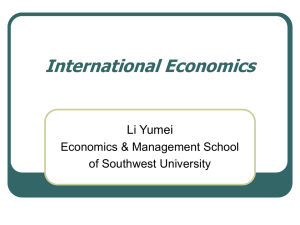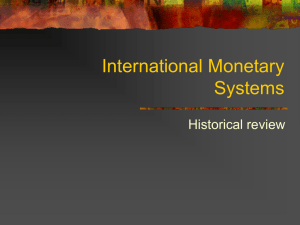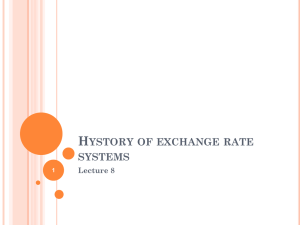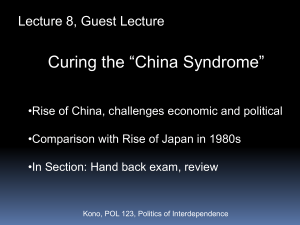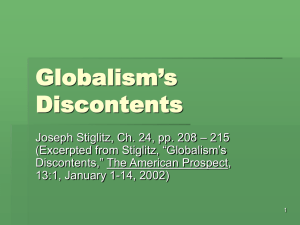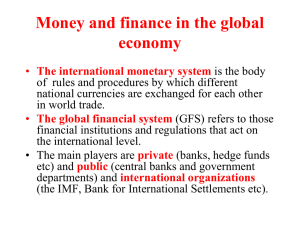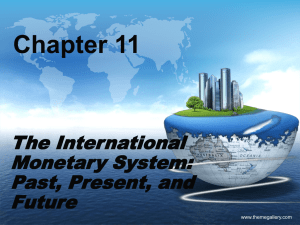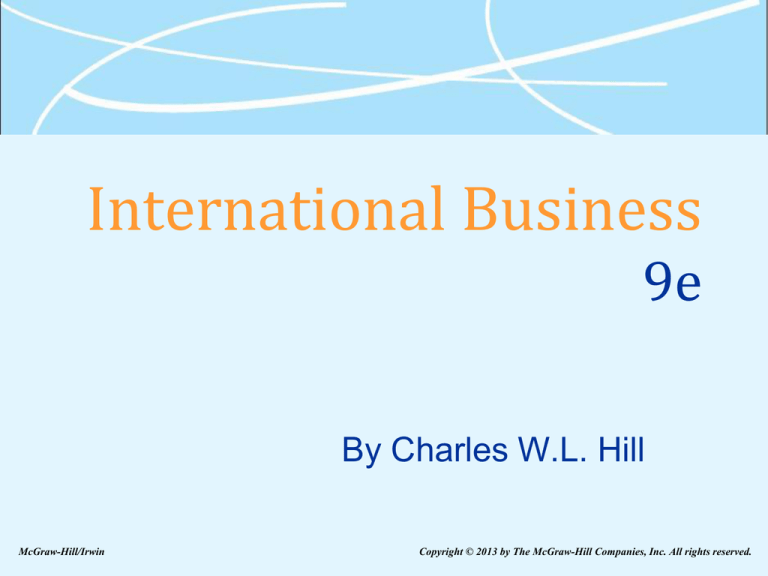
International Business
9e
By Charles W.L. Hill
McGraw-Hill/Irwin
Copyright © 2013 by The McGraw-Hill Companies, Inc. All rights reserved.
Chapter 11
The International
Monetary System
What Is The International
Monetary System?
The international monetary system refers to the
institutional arrangements that countries adopt
to govern exchange rates
A floating exchange rate system exists when a
country allows the foreign exchange market to
determine the relative value of a currency
the U.S. dollar, the EU euro, the Japanese yen, and
the British pound all float freely against each other
their values are determined by market forces and
fluctuate day to day
11-3
What Is The International
Monetary System?
A pegged exchange rate system exists when a
country fixes the value of its currency relative to
a reference currency
many Gulf states peg their currencies to the U.S.
dollar
A dirty float exists when a country tries to hold
the value of its currency within some range of a
reference currency such as the U.S. dollar
China pegs the yuan to a basket of other currencies
11-4
What Is The International
Monetary System?
A fixed exchange rate system exists when
countries fix their currencies against each
other at some mutually agreed on
exchange rate
European Monetary System (EMS) prior to
1999
11-5
What Was The Gold Standard?
The gold standard refers to a system in
which countries peg currencies to gold and
guarantee their convertibility
the gold standard dates back to ancient times
when gold coins were a medium of exchange,
unit of account, and store of value
payment for imports was made in gold or silver
11-6
What Was The Gold Standard?
later, payment was made in paper currency
which was linked to gold at a fixed rate
in the 1880s, most nations followed the gold
standard
$1 = 23.22 grains of “fine” (pure) gold
the gold par value refers to the amount of a
currency needed to purchase one ounce of
gold
11-7
Why Did The
Gold Standard Make Sense?
The great strength of the gold standard
was that it contained a powerful
mechanism for achieving balance-of-trade
equilibrium by all countries
when the income a country’s residents earn
from its exports is equal to the money its
residents pay for imports
It is this feature that continues to prompt
calls to return to a gold standard
11-8
Why Did The
Gold Standard Make Sense?
The gold standard worked well from the
1870s until 1914
but, many governments financed their World
War I expenditures by printing money and so,
created inflation
People lost confidence in the system
demanded gold for their currency putting
pressure on countries' gold reserves, and
forcing them to suspend gold convertibility
By 1939, the gold standard was dead
11-9
What Was The
Bretton Woods System?
In 1944, representatives from 44 countries met
at Bretton Woods, New Hampshire, to design a
new international monetary system that would
facilitate postwar economic growth
Under the new agreement
a fixed exchange rate system was established
all currencies were fixed to gold, but only the U.S.
dollar was directly convertible to gold
devaluations could not to be used for competitive
purposes
a country could not devalue its currency by more than
10% without IMF approval
11-10
What Institutions Were
Established At Bretton Woods?
The Bretton Woods agreement also
established two multinational institutions
1. The International Monetary Fund (IMF) to
maintain order in the international monetary
system through a combination of discipline and
flexibility
2. The World Bank to promote general economic
development
also called the International Bank for Reconstruction
and Development (IBRD)
11-11
What Institutions Were
Established At Bretton Woods?
1. The International Monetary Fund (IMF)
fixed exchange rates stopped competitive
devaluations and brought stability to the world trade
environment
fixed exchange rates imposed monetary discipline
on countries, limiting price inflation
in cases of fundamental disequilibrium,
devaluations were permitted
the IMF lent foreign currencies to members during
short periods of balance-of-payments deficit, when
a rapid tightening of monetary or fiscal policy would
hurt domestic employment
11-12
What Institutions Were
Established At Bretton Woods?
2. The World Bank
Countries can borrow from the World Bank in two
ways
1. Under the IBRD scheme, money is raised through
bond sales in the international capital market
borrowers pay a market rate of interest - the
bank's cost of funds plus a margin for expenses.
2. Through the International Development Agency, an
arm of the bank created in 1960
IDA loans go only to the poorest countries
11-13
Why Did The Fixed Exchange
Rate System Collapse?
Bretton Woods worked well until the late 1960s
It collapsed when huge increases in welfare programs
and the Vietnam War were financed by increasing the
money supply and causing significant inflation
other countries increased the value of their currencies
relative to the U.S. dollar in response to speculation
the dollar would be devalued
However, because the system relied on an economically
well managed U.S., when the U.S. began to print money,
run high trade deficits, and experience high inflation, the
system was strained to the breaking point
the U.S. dollar came under speculative attack
11-14
What Was The
Jamaica Agreement?
A new exchange rate system was established in
1976 at a meeting in Jamaica
The rules that were agreed on then are still in
place today
Under the Jamaican agreement
floating rates were declared acceptable
gold was abandoned as a reserve asset
total annual IMF quotas - the amount member
countries contribute to the IMF - were increased to
$41 billion – today they are about $300 billion
11-15
What Has Happened To
Exchange Rates Since 1973?
Since 1973, exchange rates have been
more volatile and less predictable than
they were between 1945 and 1973
because of
the 1971 and 1979 oil crises
the loss of confidence in the dollar after U.S.
inflation in 1977-78
the rise in the dollar between 1980 and 1985
the partial collapse of the EMS in 1992
the 1997 Asian currency crisis
the decline in the dollar from 2001 to 2009
11-16
What Has Happened To
Exchange Rates Since 1973?
Major Currencies Dollar Index, 1973-2010
11-17
Which Is Better – Fixed
Rates Or Floating Rates?
Floating exchange rates provide
1. Monetary policy autonomy
removing the obligation to maintain exchange rate
parity restores monetary control to a government
2. Automatic trade balance adjustments
under Bretton Woods, if a country developed a
permanent deficit in its balance of trade that could
not be corrected by domestic policy, the IMF would
have to agree to a currency devaluation
11-18
Which Is Better – Fixed Rates
Or Floating Rates?
But, a fixed exchange rate system
1. Provides monetary discipline
ensures that governments do not expand
their money supplies at inflationary rates
2. Minimizes speculation
causes uncertainty
3. Reduces uncertainty
promotes growth of international trade and
investment
11-19
Who Is Right?
There is no real agreement as to which
system is better
We know that a Bretton Woods-style fixed
exchange rate regime will not work
But a different kind of fixed exchange rate
system might be more enduring
could encourage stability that would facilitate
more rapid growth in international trade and
investment
11-20
What Type of Exchange Rate
System Is In Practice Today?
Various exchange rate regimes are followed
today
14% of IMF members follow a free float policy
26% of IMF members follow a managed float system
22% of IMF members have no legal tender of their
own
ex. Euro Zone countries
the remaining countries use less flexible systems
such as pegged arrangements, or adjustable pegs
11-21
What Type of Exchange Rate
System Is In Practice Today?
Exchange Rate Policies of IMF Members
11-22
What Is A Pegged Rate
System?
A country following a pegged exchange
rate system pegs the value of its currency
to that of another major currency
popular among the world’s smaller nations
imposes monetary discipline and leads to low
inflation
adopting a pegged exchange rate regime can
moderate inflationary pressures in a country
11-23
What Is A Currency Board?
Countries using a currency board commit
to converting their domestic currency on
demand into another currency at a fixed
exchange rate
the currency board holds reserves of foreign
currency equal at the fixed exchange rate to
at least 100% of the domestic currency issued
the currency board can issue additional
domestic notes and coins only when there are
foreign exchange reserves to back them
11-24
What Is The Role
Of The IMF Today?
Today, the IMF focuses on lending
money to countries in financial crisis
There are three main types of financial
crises:
1. Currency crisis
2. Banking crisis
3. Foreign debt crisis
11-25
What Is The Role
Of The IMF Today?
A currency crisis
occurs when a speculative attack on the
exchange value of a currency results in a
sharp depreciation in the value of the
currency, or forces authorities to expend large
volumes of international currency reserves
and sharply increase interest rates in order to
defend prevailing exchange rates
Brazil 2002
11-26
What Is The Role
Of The IMF Today?
A banking crisis refers to a situation in which a
loss of confidence in the banking system leads
to a run on the banks, as individuals and
companies withdraw their deposits
A foreign debt crisis is a situation in which a
country cannot service its foreign debt
obligations, whether private sector or
government debt
Greece and Ireland 2010
11-27
What Was The Mexican
Currency Crisis Of 1995?
The Mexican currency crisis of 1995 was a
result of
high Mexican debts
a pegged exchange rate that did not allow for
a natural adjustment of prices
To keep Mexico from defaulting on its
debt, the IMF created a $50 billion aid
package
required tight monetary policy and cuts in
public spending
11-28
What Was The
Asian Currency Crisis?
The 1997 Southeast Asian financial crisis was
caused by events that took place in the
previous decade including
1. An investment boom - fueled by huge increases in
exports
2. Excess capacity - investments were based on
projections of future demand conditions
3. High debt - investments were supported by dollarbased debts
4. Expanding imports – caused current account
deficits
11-29
What Was The
Asian Currency Crisis?
By mid-1997, several key Thai financial
institutions were on the verge of default
speculation against the baht
Thailand abandoned the baht peg and allowed
the currency to float
The IMF provided a $17 billion bailout loan
package
required higher taxes, public spending cuts,
privatization of state-owned businesses, and higher
interest rates
11-30
What Was The
Asian Currency Crisis?
Speculation caused other Asian currencies
including the Malaysian Ringgit, the Indonesian
Rupaih and the Singapore Dollar to fall
These devaluations were mainly driven by
excess investment and high borrowings, much of it in
dollar denominated debt
a deteriorating balance of payments position
11-31
What Was The
Asian Currency Crisis?
The IMF provided a $37 billion aid package for
Indonesia
required public spending cuts, closure of troubled
banks, a balanced budget, and an end to crony
capitalism
The IMF provided a $55 billion aid package to
South Korea
required a more open banking system and economy,
and restraint by chaebol
11-32
How Has The IMF Done?
By 2010, the IMF was committing loans to 68
countries in economic and currency crisis
All IMF loan packages require tight
macroeconomic and monetary policy
However, critics worry
the “one-size-fits-all” approach to macroeconomic
policy is inappropriate for many countries
the IMF is exacerbating moral hazard - when people
behave recklessly because they know they will be
saved if things go wrong
the IMF has become too powerful for an institution
without any real mechanism for accountability
11-33
How Has The IMF Done?
But, as with many debates about international
economics, it is not clear who is right
However, in recent years, the IMF has started to
change its policies and be more flexible
urged countries to adopt fiscal stimulus and monetary
easing policies in response to the 2008-2009 global
financial crisis
11-34
What Does The Monetary
System Mean For Managers?
Managers need to understand how the
international monetary system affects
1. Currency management - the current system is
a managed float - government intervention can
influence exchange rates
speculation can also create volatile movements in
exchange rates
11-35
What Does The Monetary
System Mean For Managers?
2. Business strategy - exchange rate movements
can have a major impact on the competitive
position of businesses
need strategic flexibility
3. Corporate-government relations - businesses
can influence government policy towards the
international monetary system
companies should promote a system that facilitates
international growth and development
11-36



